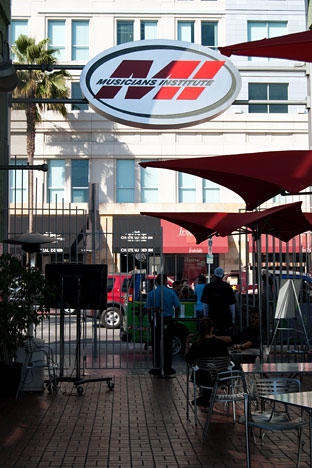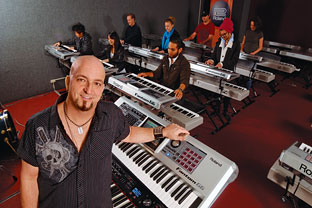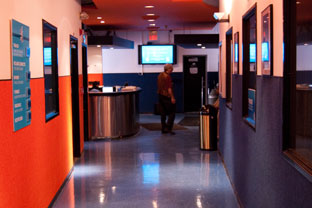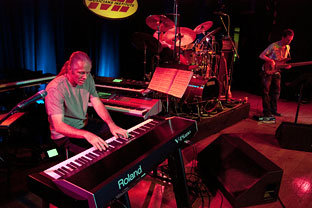Creative Solutions For Inspired Learning
Menu
Creative Solutions For Inspired Learning
MenuBy Shane Cadman

Musicians Institute (Los Angeles, CA).
“Anything you can’t do, any weakness that you have, is a way to potentially say ‘no’ to work. My objective for the students is to know in the back of their mind that they have every tool when they graduate, to let that become a possible stream of income.” –Kevin Comstock
Kevin Comstock, the head of the keyboard program at Musicians Institute (MI) in Los Angeles, is passionate about music. He’s also passionate about music education, music technology and Roland. With this passion, there’s no better place for him to be than at MI, and we’re guessing that most of the students don’t know how fortunate they are to have him there.
In February of 2010, Roland had a chance to sit down and talk with Kevin about MI, Roland, and what it means to be a contemporary keyboard player.
MI is the outgrowth of the world famous Guitar Institute of Technology (GIT). Before GIT opened its doors to full-time students in 1977, there were few options for those who wanted to study contemporary popular music. But GIT was about to change that in a major way. With the addition of the Bass Institute of Technology (BIT) in 1978 and the Percussion Institute of Technology (PIT) in 1980, MI came into being, and since that time they have added a number of programs, including one specifically for keyboardists.
“If you use a keyboard to make music, we’re going to have something for you.”
KIT is the Keyboard Institute of Technology, just one of the programs at MI. In the words of MI:
MI's Keyboard education takes an innovative approach to an instrument that is both deeply traditional and constantly evolving. The unique curriculum combines traditional keyboard performance with cutting-edge keyboard-based technology. As a performer, you develop your keyboard skills and explore a range of contemporary styles including Funk, R&B, Blues, Jazz, Country, Rock, Fusion, Afro-Cuban, and Brazilian under the direction of some of LA's best working professionals. At the same time, you learn how to use the electronic keyboard's vast capabilities for sampling, drum programming, production, digital recording, and arranging.
And what better way to learn about the capabilities of electronic keyboards than with Roland instruments?

Kevin Comstock, the head of the keyboard program at Musicians Institute (MI) in Los Angeles.
Kevin recognizes that to be a working keyboardist these days means more than simply playing piano or organ, and it’s still going to take some work.
“The focus of our program, the one thing that we take a lot of pride in, is this idea that to be a contemporary keyboardist is more than piano skills. You still have to have the piano skills, but nowadays as keyboardists, we’re utility players. If there’s a bell, a buzz, a whistle, a pop, a sizzle in a song, the keyboardist is the guy that’s expected to pick that up. To find a place to sample it, to put it on the keyboard, and to play that part. The days of putting up a piano patch and just jamming endlessly through a song—those days are over. If you want work, you’ve got to be able to do the other side of it, so our program is 50% technology-based and 50% performance-based. For us, really what makes us special is you’re going to come and we’re going to work you on both sides. That said, it’s going to be a lot of work. And I always tell them [the students], when you’re 90, and you look back at this 1/90th of their life, I guarantee you, you won’t say ‘Man, I worked too hard that 1/90th of my life.’”
“I’ve been using Roland keyboards for 25 years. I’m a big Roland fan. The nice thing is, you know, for the most part, Roland’s terminology, technology, and technology-style has been the same, just expanding. So, when you get a way of thinking, you can grasp it and follow it even as the technology changes, which I think is very beneficial. Also, I’m partial to Roland because I like the ease of use. On Roland, it’s really intuitive. Even if I don’t know what I’m doing, I can figure it out much faster [than on other companies’ products].”
When Kevin first came to MI, the keyboards were showing the wear and tear of a 24-hour facility. MI literally has students practicing around the clock. When it came time to purchase new keyboards, he explored a number of options, but because of his history as a player of Roland instruments, Roland was an obvious choice. But it wasn’t just about the products.
“From a customer-service point of view, the reason our relationship is with Roland is because of good customer service on Roland’s end. That’s really what it comes down to.”

Walking the halls of Musicians Institute.
Once the approval came to buy the instruments, Kevin needed to figure out what was going to work best for both the school and the students.
“So immediately, the first thing I did was talked with Corey [Fournier, Roland Market Development Manager] about what our needs were and what we could do. We got 12 Fantom-G6s and eight SH-201s.”
“The SH-201s—interesting story. Since I’ve been there, we’ve been teaching basis synthesis, but we’ve been teaching it using the ES2 in Logic. So, the students sit and they bring up this space shuttle-looking object that looks like a UFO and then they use their mouse to turn the knobs on there, and they create sounds. But when I got here, I noticed that not one student—except for the students who were gadget heads and had that in them—not one student could transfer that same knowledge to a hardware-based synth. It wasn’t that they didn’t know how, it was that they just didn’t see that that was a representation of that. So, that was the first thing I had to do for our basic synth class. I had to get those 201s in there. They [the students] are sitting with the keyboards. ‘You got knobs in front of you. Start twisting those knobs and hearing what it does.’”
Seeing as this is a family-friendly article, we can’t print the exact reactions from the students when they walked into their brand-new Fantom workstation lab, but suffice it to say they were excited. And you would be, too, if you had one of the latest, most powerful and widely used workstations in the music world to learn on—the Roland Fantom-G, which has a 8.5" wide LCD screen right in the middle of it.
“With the Fantom, they [Roland] gave us the curriculum materials for the Fantom that were all really well done, and we’ve taken that and turned it into a 10-week class. Obviously, the Fantom is too deep to be able to get to everything we need to in 10 weeks, but we do a pretty nice overview class. We’ve actually had so many students who are motivated in that class that we’ve added open counseling after the class, which means that the instructor just stays there and continues the discussion. Because obviously we hit on what we think are the important points for students to learn on the instruments, but the students have their own questions as well and we don’t want to just push those aside. So, we’ve done that.”

Roland’s Scott Tibbs performs at the 2009 Keyz ’n Beats Summit: a collaboration between Roland, Musicians Institute, and Keyboard Magazine.
While the Fantom line is new to some students, it’s not the case with all of them.
“Many of our students already had Fantoms at home that they were using, so to be able to suddenly have what they use at home here, and they can use the little flash drive and come in and bring the sounds from home, [made them more productive]. But also, many of the students have one but have no idea how to use it, so we also took that to the next level. Besides that, they’re using them in their projects and their projects are sounding better than ever. I mean they’re really sounding cool. And we’re constantly freaking out with all the things you can do with those things. You could put the Fantom-G6 into the back of a tour bus and you have your recording studio.”
The reputation of MI and the Fantom lab is even reaching prospective students.
“I got my first application from a student who said on the application ‘Why are they coming to MI?’ It said ‘I want to learn to use my Fantom.’”
Kevin not only uses the Fantom in the classroom, but uses one as part of his own keyboard rig.
“I was making a transition. Before I had seen the Fantom, I was making a transition to being a completely soft-synth player—88-key controller and soft-synths—and then once I saw those [Fantoms], I was like ‘Maybe I like hardware synths again.’ And now I’m really realizing that as a keyboardist you need both now.”
“The difference between being able to play and maintaining a professional career is to encompass a lot more of the skills than just being able to play. That doesn’t take anything away. The better you can play, the more likely you’re going to have the ability to say ‘yes’ to work, whatever that work is.”
With new programs and features constantly in development, MI is dedicated to remaining “The World's Most Innovative School of Contemporary Music,” and Roland will be there all the way.